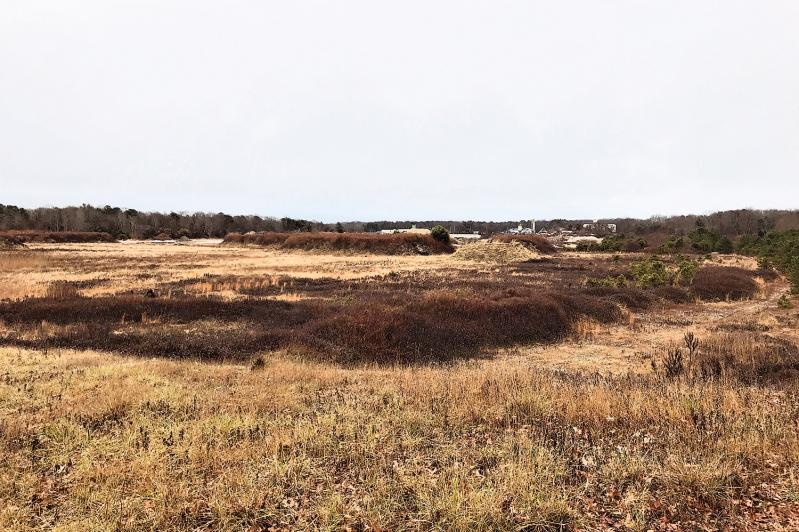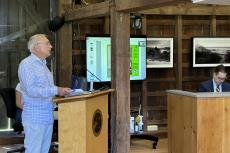The East Hampton Town Planning Board did last week what it has taken nearly five years to do: agreed that the draft environmental impact statement for the Wainscott Commercial Center was complete.
The vote closes a chapter in the saga of the 70.4-acre former sand mine, located just north of the Speedway Station in Wainscott, and opens another, as a public comment period has now begun.
The vote was not unanimous. In keeping with his outsider status on the application, Randy Parsons was the lone board member who said the impact statement was not complete.
A vote on the statement’s “completeness is not a formal approval,” explained Dan Rizzo, a town attorney. “It allows the formal public comment process to begin. Items listed in the final scoping outline for the D.E.I.S. have now been addressed [by the applicant]. It isn’t a judgement that the consultants or board or planning staff agree with everything, it’s just that they’ve adequately addressed it.”
Because of its location, development of the Wainscott Commercial Center, owned by the Tintle family since the 1980s, could have a significant impact. The Wainscott Hamlet Study of 2019 called the area the “Gateway to East Hampton.” If it were approved in its current form, a grid of 50 commercial lots would be placed in the parcel, impacting traffic on one of the busiest stretches of Route 27 in the town.
Georgica Pond, whose headwaters are just a few hundred feet southeast of the lot, could also be negatively impacted by stormwater runoff and polluted groundwater from the site.
The town’s 2005 comprehensive plan sought to “prevent the Gateway to East Hampton from turning into a congested commercial highway strip,” and the town’s 2019 Wainscott hamlet study showed a conceptual framework for the redevelopment of the sand pit that included more than half the space being used as a public park, with smaller areas set aside for housing, and a multi-use trail connecting to a proposed Long Island Rail Road station.
As part of New York State’s Environmental Quality Review Act, applicants with a project of this size must provide alternatives to their proposal. One of the main reasons why Mr. Parsons voted that the D.E.I.S. was incomplete was because he said Wainscott Commercial had not done enough to explore alternate sites for the 50 commercial lots the owners say are necessary.
“They left out the largest commercial industrial holding in the town,” he said, speaking of a parcel owned by Bistrian Sand and Gravel, off Springs-Fireplace Road in East Hampton.
“But it’s not for sale,” said Samuel Kramer, the board’s chairman.
“I don’t know that that’s relevant,” said Mr. Parsons. “If you’re inventorying the potential for C.I. lots in the town, why wouldn’t you take into account the largest C.I. holding that will eventually come before us?”
“This omission results in a major distortion in the applicants’ D.E.I.S. justification of the need for 50 C.I. parcels on Montauk Highway in Wainscott,” Mr. Parsons wrote in a letter to the board, the Planning Department, and the Planning Department attorney.
The biggest flashpoint of the evening however, had nothing to do with the D.E.I.S., but instead with Mr. Parsons’s assertion that the application might need a special permit for a planned industrial park.
“The special permit requirement was adopted for the town for applications specifically like this one,” he said.
David Eagan, the attorney for Wainscott Commercial, strongly disagreed. He accused Mr. Parsons of trying to delay the application and said that since no specific uses have been proposed, applying a special permit to hypothetical uses was impossible. He said in 2001, Mr. Parsons, as owner of Land Marks Planning and Conservation, was working for the Tintle family when he drafted a D.E.I.S. for a separate project. Mr. Eagan said he thought it strange that Mr. Parsons didn’t think it required a special permit back then.
Mr. Eagan said the Tintles later voluntarily removed that application while they waited for the town to develop its 2005 comprehensive plan. However, the current plan runs strongly counter to that 16-year-old plan.
“His lack of objectivity is creating a real legal problem for you,” Mr. Eagan said of Mr. Parsons. “It’s evident, and it’s splattered through the record, and this is another manifestation of it.”
He pushed the board to decide that a special permit wasn’t required.
But the planning board came to the defense of Mr. Parsons, who had brought up the potential need for a special permit over a year ago.
“I apologize, because when Mr. Parsons did bring this up, we glossed over it, and I think that was a mistake,” said Ian Calder-Piedmonte, a board member.
“When we’re faced with a legal ambiguity, it’s the practice of this board to go to the building inspector for clarification,” said Mr. Kramer, doubting that it would take years to get that determination, as Mr. Eagan suggested. “Regardless of what member brings up a concern or how you feel about that member, isn’t that a valid reason to look into the issue?” he asked.
Lou Cortese, another board member, said that Mr. Parsons was acting on the Tintles’ behalf 20 years ago, and much as a lawyer advocates for his client, wouldn’t have pushed for a special permit if it was a detriment to the Tintles.
Mr. Eagan seemed appeased by the town attorney, who suggested that the special permit would not require lots of extra environmental work or analysis, or affect the status of the D.E.I.S.
The need for a special permit “doesn’t change the completeness,” of the D.E.I.S., said Mr. Kramer.
“Besides that, the D.E.I.S. is not the final environmental impact statement,” said Mr. Calder-Piedmonte, “and I would say if a special permit is required that’s new information, and before the F.E.I.S. comes out, we could roll whatever detail had to be rolled into that.”
“You’re also deeming the preliminary map, which is the primary map in any subdivision, you’re deeming that complete before you get an answer” to the special permit question,” said Mr. Parsons.
“But Randy, it can easily be complete and not accepted,” said Mr. Calder-Piedmonte. “Because we decide it’s not a good subdivision, whether it needs a special permit or doesn’t.”
“That’s the fundamental point,” said Mr. Kramer.
“But you are going down a road with this layout,” said Mr. Parsons, pressing.
“But with comment it could completely change,” said Sharon McCobb, a board member.
“We’re going down the road with this layout for an eventual vote. The vote isn’t necessarily a ‘yes’ vote,” said Mr. Calder-Piedmonte.
The date for the public hearing has yet to be set, but the Planning Department is hoping for January or February. Because many people are expected to attend, it is trying to coordinate use of LTV studios. Regardless, the public will have until at least Feb. 28 to submit written comments.
Those concerned don’t have to wait for the in-person hearing to submit comments. Now that the D.E.I.S. has been approved, the planning board can begin to receive written comments.
“The objective is to get substantive comments,” said Mr. Rizzo. “Public expressing support for or against is interesting, but for SEQRA purposes, it doesn’t advance the ball very far. If there are facts that need to be highlighted that someone believes the D.E.I.S. doesn’t contain completely, that will help the board.”
The final environmental impact statement will summarize and respond to all the substantive comments.
“I think the public should submit written comments,” said Mr. Calder-Piedmonte, after which, “there may be changes” made to the draft impact statement.
“I hope there are,” said Mr. Parsons.
“That’s the whole point of public comment,” said Mr. Kramer.




